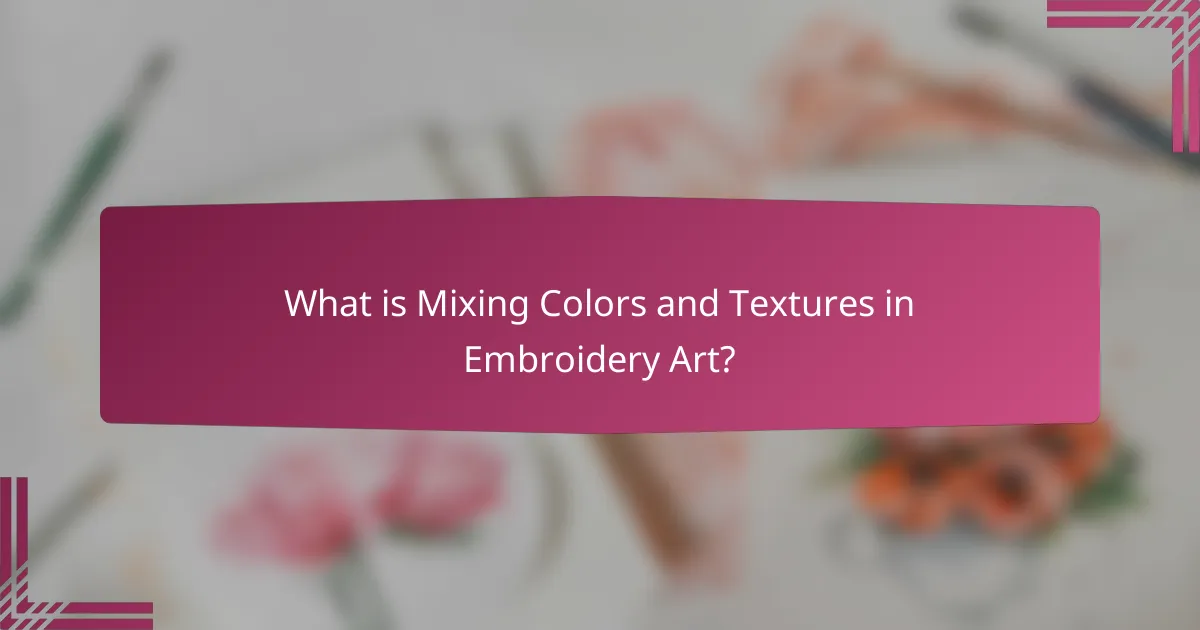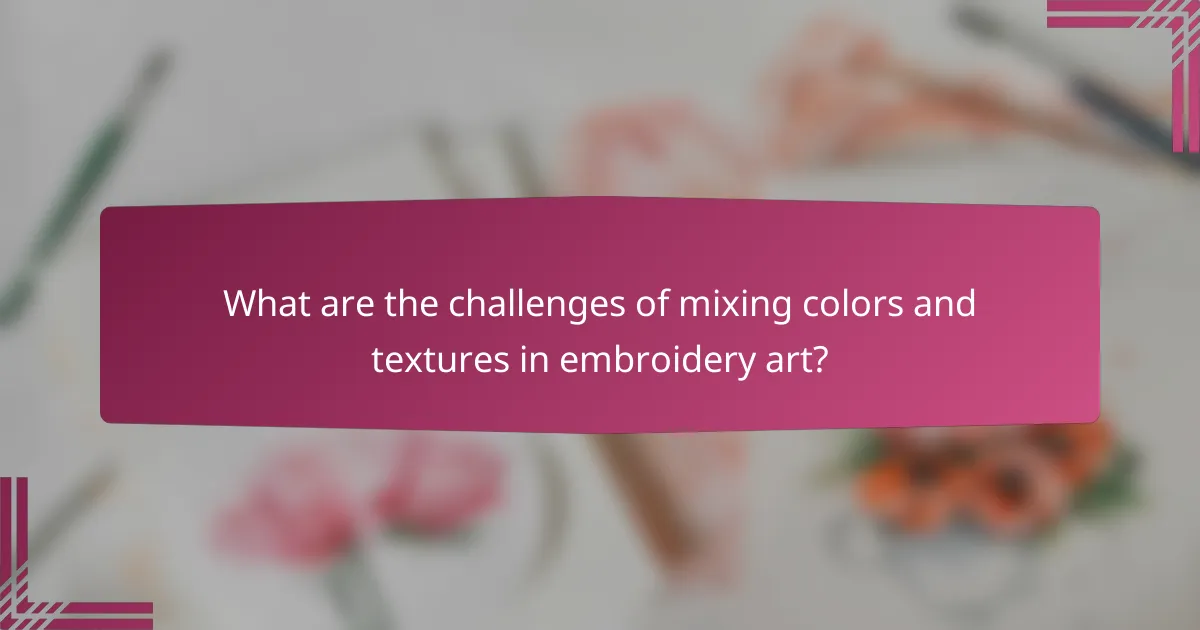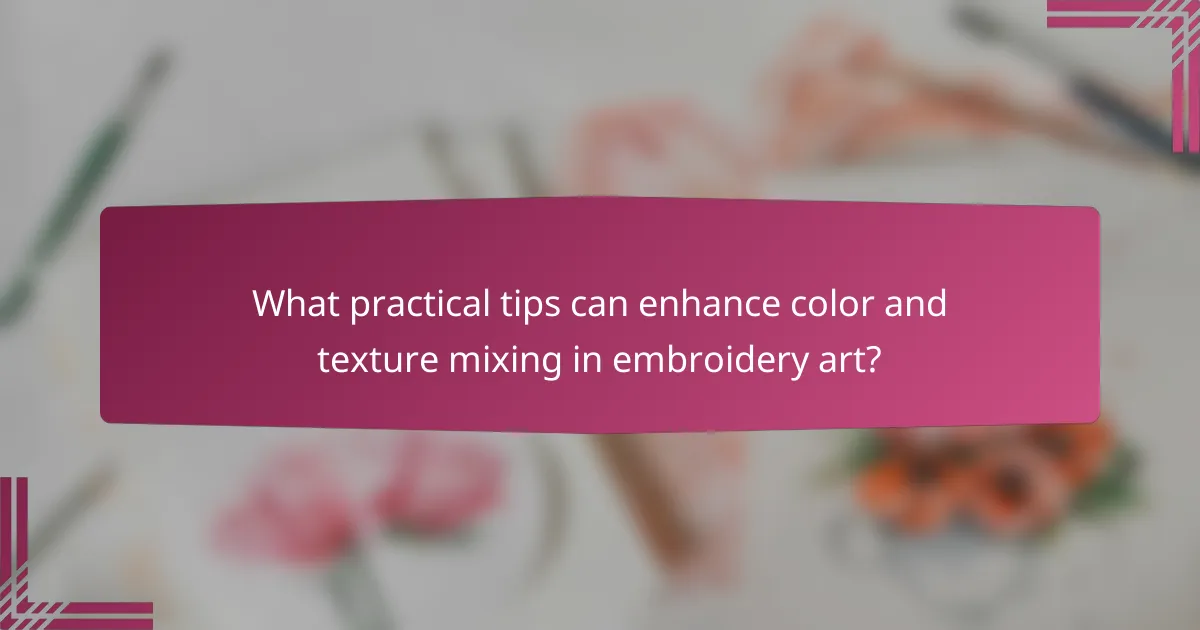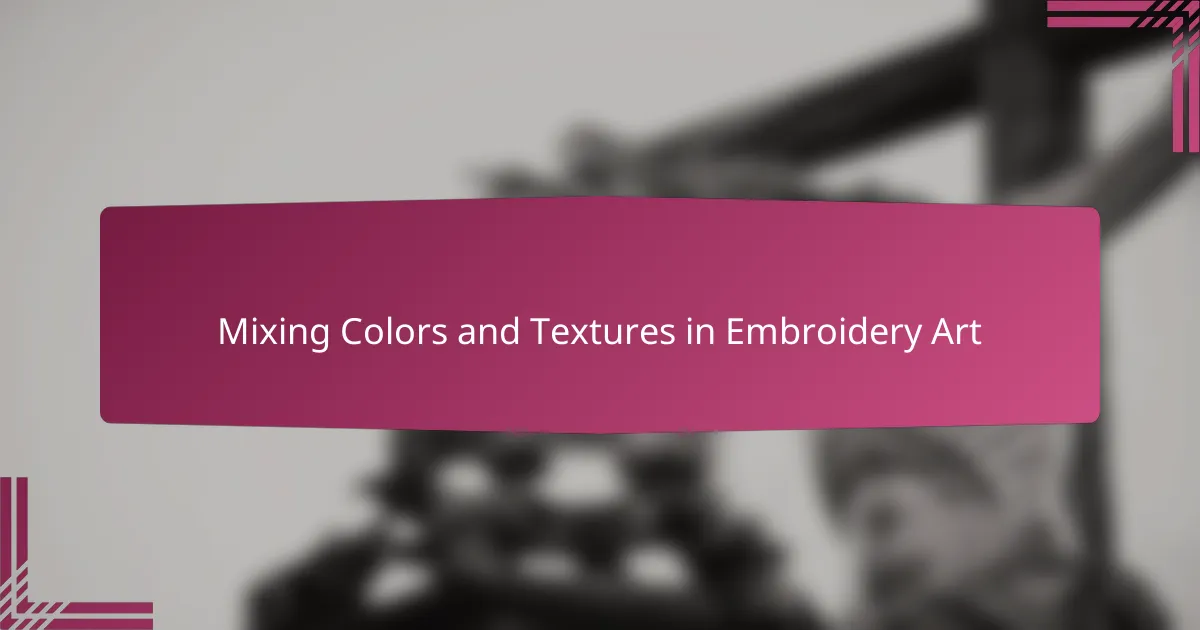
What is Mixing Colors and Textures in Embroidery Art?
Mixing colors and textures in embroidery art involves combining different hues and fabric types to create visually appealing designs. This technique enhances the depth and dimension of the artwork. Color mixing can include blending shades to achieve gradients or contrasting colors for emphasis. Texture mixing may involve using various stitches or materials, such as silk, cotton, or metallic threads. These elements work together to elevate the overall aesthetic of the embroidery. Artists often experiment with color palettes and texture combinations to express their creativity. Historical examples show that diverse textiles and colors have been used in embroidery for centuries, showcasing cultural significance and artistic expression.
How does color influence the overall design in embroidery art?
Color significantly influences the overall design in embroidery art. It affects visual appeal, emotional response, and thematic coherence. Different colors can evoke specific feelings, such as warmth from reds or calmness from blues. The choice of color combinations can create contrast or harmony in the design. High contrast can draw attention to specific elements, while harmonious colors can unify the piece. Historical context shows that color symbolism varies across cultures, impacting design choices. For example, in many cultures, white symbolizes purity, while red may signify passion. Therefore, understanding color theory is essential for effective embroidery design.
What are the basic color theory principles relevant to embroidery?
The basic color theory principles relevant to embroidery include the color wheel, color harmony, and color contrast. The color wheel organizes colors into primary, secondary, and tertiary categories. Primary colors are red, blue, and yellow. Secondary colors, created by mixing primary colors, are green, orange, and purple. Tertiary colors are formed by mixing primary and secondary colors.
Color harmony refers to the pleasing arrangement of colors. It can be achieved through complementary, analogous, or triadic color schemes. Complementary colors are opposite each other on the color wheel. Analogous colors are next to each other. Triadic schemes use three colors evenly spaced around the wheel.
Color contrast involves the use of differing colors to create visual interest. High contrast can make elements stand out, while low contrast can create a more subdued look. These principles help embroiderers choose and combine colors effectively for aesthetic appeal.
How do different color combinations affect the viewer’s perception?
Different color combinations significantly influence viewer perception. Colors can evoke emotions and convey messages. For example, warm colors like red and yellow can create feelings of warmth and excitement. In contrast, cool colors such as blue and green often induce calmness and tranquility.
Research indicates that complementary colors, like blue and orange, enhance visual appeal and create a sense of balance. Analogous colors, such as blue, green, and yellow, provide harmony and cohesiveness. The context of colors also matters; cultural associations can alter interpretations.
A study in the Journal of Environmental Psychology found that color combinations affect mood and behavior. Participants exposed to vibrant color palettes reported higher energy levels. Conversely, muted colors led to feelings of relaxation. These findings highlight the importance of color selection in embroidery art to influence viewer experiences.
What role does texture play in embroidery art?
Texture is a crucial element in embroidery art that enhances visual interest and depth. It influences the overall aesthetic by adding dimension and richness to the design. Different stitching techniques create varied textures, such as smooth, raised, or patterned effects. These textures can evoke emotions and convey messages within the artwork. Additionally, the choice of materials, like threads and fabrics, further affects the textural outcome. For example, thick threads produce a bold texture, while fine threads create a delicate appearance. The interplay of texture and color also contributes to the harmony of the piece. Overall, texture plays a vital role in defining the character and impact of embroidery art.
How can various textures enhance the visual appeal of embroidery?
Various textures enhance the visual appeal of embroidery by adding depth and dimension. Textures can create contrast, making elements stand out more vividly. Different thread types, such as matte and shiny, contribute to a dynamic visual experience. Techniques like layering can introduce tactile interest that invites closer inspection. Additionally, textured stitches can evoke specific themes or emotions in the artwork. For example, raised stitches can suggest softness or warmth. The interplay of textures can also guide the viewer’s eye across the piece. This multifaceted approach enriches the overall aesthetic and engagement with the embroidery.
What are the common types of textures used in embroidery?
Common types of textures used in embroidery include smooth, raised, and fluffy textures. Smooth textures are achieved through techniques like satin stitch. Raised textures often utilize techniques such as puff embroidery. Fluffy textures can be created with materials like chenille. Other textures include woven and textured stitch patterns. Each texture contributes to the overall visual appeal of the embroidery. The choice of texture can enhance the design and make it more dynamic. Different threads and stitches can also influence the texture achieved in embroidery.
How can colors and textures be effectively combined in embroidery?
Colors and textures can be effectively combined in embroidery by using contrasting and complementary shades. Selecting a color palette that includes both warm and cool tones enhances visual interest. Incorporating various thread types, such as matte and shiny, adds depth to the design. Layering stitches with different textures creates a dynamic effect. For example, using satin stitches alongside French knots can emphasize specific areas. Additionally, considering the fabric type influences how colors and textures appear together. Experimentation with color placement and stitch techniques leads to unique outcomes. Studies show that thoughtful combinations can significantly enhance the overall aesthetic appeal of embroidered pieces.
What techniques can be used to blend colors in embroidery projects?
Techniques to blend colors in embroidery projects include gradient stitching, color layering, and thread mixing. Gradient stitching involves gradually changing thread colors along a design. This creates a smooth transition and depth. Color layering uses different thread colors on top of each other to achieve a blended effect. This technique adds texture and richness. Thread mixing combines multiple strands of different colors in one stitch. This technique results in a unique and varied appearance. Each method enhances the visual appeal of the embroidery.
How do different textures complement or contrast with colors?
Different textures can enhance or oppose colors in visual art. Textures can create depth and interest, influencing how colors are perceived. For instance, a rough texture can make a color appear more vibrant. Conversely, a smooth texture may soften the appearance of a color. This interaction is crucial in embroidery art, where the tactile quality impacts visual appeal. Research indicates that textures can alter color perception significantly, as seen in studies on visual contrast. The combination of textures and colors can evoke various emotional responses, enhancing the overall artistic expression.

What are the challenges of mixing colors and textures in embroidery art?
Mixing colors and textures in embroidery art presents several challenges. One challenge is achieving color harmony. Different colors can clash or create an unbalanced look. Another challenge is the compatibility of textures. Some textures may not complement each other, leading to a disjointed appearance. Additionally, varying thread thickness can affect the overall visual impact. This inconsistency can disrupt the design’s flow. The choice of fabric also influences how colors and textures interact. Certain fabrics absorb colors differently, altering their appearance. Lastly, the skill level of the embroiderer plays a crucial role. Inexperienced artists may struggle to visualize the final outcome.
What common mistakes should be avoided when combining colors and textures?
Common mistakes to avoid when combining colors and textures include using clashing colors, which can create visual chaos. Another mistake is neglecting contrast, as insufficient contrast can make designs look flat. Overloading with too many textures can overwhelm the viewer and distract from the overall design. Failing to consider the scale of textures can lead to imbalance; large textures may dominate small ones. Ignoring the color wheel can result in unharmonious combinations. Lastly, not testing combinations in natural light may lead to unexpected results.
How can poor color choices impact the final embroidery piece?
Poor color choices can significantly diminish the quality of the final embroidery piece. Inappropriate colors may clash, leading to a visually unappealing design. This can result in a lack of harmony and balance in the artwork. Additionally, poor color selection can obscure intricate details and patterns within the embroidery. When colors do not complement each other, the overall impact can be less striking. Research indicates that color theory plays a crucial role in design effectiveness. Studies show that harmonious color combinations enhance viewer engagement and satisfaction. Therefore, careful consideration of color choices is essential for achieving a successful embroidery piece.
What texture combinations can lead to visual clutter in embroidery?
Combining multiple textures in embroidery can lead to visual clutter. For example, pairing heavy fabrics like denim with delicate lace can create confusion in the design. Similarly, using varied stitch types, such as satin and French knots, without a clear focal point can overwhelm the viewer. High-contrast textures, like rough burlap alongside smooth silk, can also clash visually. The lack of harmony among textures disrupts the overall aesthetic. Research indicates that balance in texture is essential for clarity in visual arts. A study by the Textile Society highlights that excessive texture variation can distract from the intended message of the embroidery.
How can one troubleshoot issues related to color and texture mixing?
To troubleshoot issues related to color and texture mixing, first identify the specific problem. Common issues include colors appearing muddy or textures not blending well. Adjust the proportions of colors used in the mix. Too much of a strong color can dominate the mix. Test small samples before applying to the main piece. This allows for adjustments without wasting materials.
Consider the type of thread or fabric used. Different materials can affect how colors appear when mixed. For example, synthetic threads may reflect light differently than natural fibers. Ensure that the mixing technique is appropriate for the desired outcome. Techniques like layering or blending can yield different results.
Lastly, consult color theory principles. Understanding complementary and analogous colors can help in achieving the desired effect. Reference resources such as “The Color Mixing Bible” by Ian Sidaway for deeper insights into color interactions.
What steps can be taken to correct color mismatches in embroidery?
To correct color mismatches in embroidery, first identify the specific colors that are mismatched. Compare the thread colors used in the embroidery with the original design colors. Adjust the thread selection by choosing colors that closely match the intended shades. Test the new thread colors on a sample fabric before applying them to the final piece. Use color charts or swatches to ensure accuracy in color matching. If necessary, consider re-stitching the affected areas with the corrected thread colors. Additionally, consult with color theory resources to understand color blending techniques. This process helps achieve a cohesive and visually appealing embroidery result.
How can texture problems be resolved in an embroidery project?
To resolve texture problems in an embroidery project, adjust the tension settings on the sewing machine. Proper tension ensures the thread lays flat and evenly. If the fabric puckers, reduce the tension. If the stitches are loose, increase the tension. Another solution is to use an appropriate stabilizer. Stabilizers prevent distortion and maintain the fabric’s shape during stitching. Choosing the right needle size for the fabric type also impacts texture. A needle that is too thick can create holes, while a too-fine needle may cause skipped stitches. Additionally, consider the thread type; using a thicker thread can enhance texture. Testing on scrap fabric before the final project can help identify issues. These adjustments can significantly improve the overall texture in embroidery.

What practical tips can enhance color and texture mixing in embroidery art?
Use a color wheel to understand complementary and analogous colors. This helps in selecting harmonious shades. Experiment with different thread types to create varied textures. For instance, mixing cotton with silk can add depth. Layering stitches enhances both color and texture effects. Use varying stitch lengths for visual interest. Test combinations on a sample fabric before the final piece. Keep a color journal to track successful mixes and techniques.
What are some best practices for selecting colors and textures in embroidery?
Best practices for selecting colors and textures in embroidery include considering color theory and contrast. Use a color wheel to identify complementary colors for visual harmony. Selecting textures can enhance the design’s depth and dimension. Combining smooth threads with textured fabrics creates visual interest. Testing color combinations on a small scale ensures compatibility. Lighting conditions can affect color perception; evaluate colors in natural light. Lastly, consider the fabric type, as it impacts how colors appear when stitched.
How can experimenting with samples improve your embroidery designs?
Experimenting with samples can significantly enhance your embroidery designs. This practice allows for exploration of different color combinations and textures. By creating sample pieces, you can visualize the impact of various threads and fabrics. It helps in identifying which elements work harmoniously together. Additionally, testing samples can reveal unforeseen challenges in stitching techniques. This proactive approach minimizes errors in final projects. Research shows that hands-on experimentation fosters creativity and innovation in design. Ultimately, sampling leads to more refined and unique embroidery outcomes.
What resources are available for learning more about color and texture in embroidery?
Books on embroidery techniques provide foundational knowledge on color and texture. “The Embroidery Book” by Charlotte Gerlings is a comprehensive resource. Online courses on platforms like Craftsy and Skillshare offer video tutorials. Websites such as Embroidery.com feature articles and forums for community advice. YouTube channels dedicated to embroidery showcase practical demonstrations. Local craft stores often host workshops focused on color mixing and texture application. Social media groups provide a platform for sharing experiences and tips. These resources collectively enhance understanding and skills in color and texture in embroidery.
Mixing colors and textures in embroidery art is the primary focus of this article, which explores how these elements enhance visual appeal and artistic expression. Key topics include the influence of color on design, basic color theory principles, and the role of texture in creating depth. The article also addresses challenges in combining colors and textures, common mistakes to avoid, and practical tips for effective mixing. Additionally, it offers resources for further learning about color and texture in embroidery, providing a comprehensive understanding of this artistic technique.
